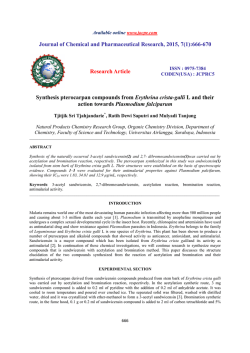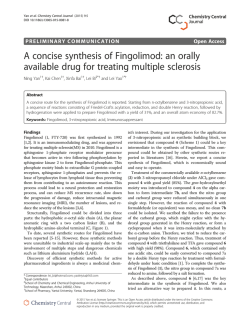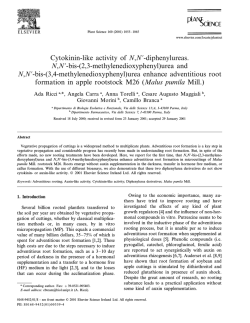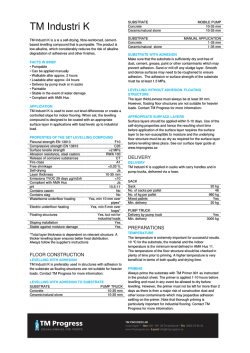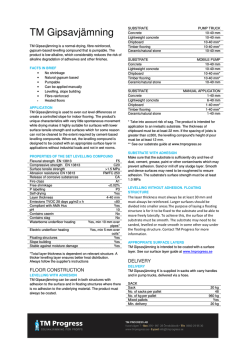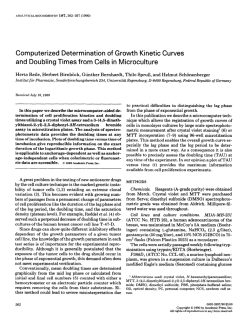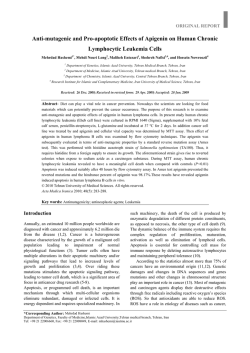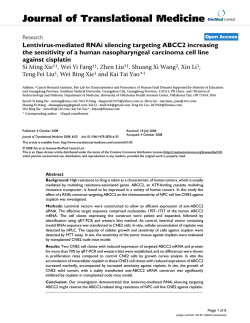
Anticancer activity of a constituent from Moringaoleiferaleaves
Available online www.jocpr.com Journal of Chemical and Pharmaceutical Research, 2015, 7(1):701-705 Research Article ISSN : 0975-7384 CODEN(USA) : JCPRC5 Anticancer activity of a constituent from Moringa oleifera leaves H. Kaur* and Shantanu Department of Chemistry, Lovely Professional University, Phagwara, Punjab _____________________________________________________________________________________________ ABSTRACT A new long-chain glucoside was isolated from methanolic extract of Moringa oleifera leaves and identified as β-Dglucopyranosidetetradecanoate along with β-sitosterol and β-sitosterolglucoside. β-sitosterolglucoside was first report from this plant. Cytotoxicity bioassay against four human cancer lines was carried out. The compound exhibited good activity against colon cancer cell line (Colo-320 DM) with IC90 value of 3.98. The compound showed moderate to low activity against other 3 cell lines (PA-1, MCF-7 and KB-403). Key words: Moringa oleifera,β-D-glucopyranosidetetradecanoate, Cytotoxicity, Colo-320 DM, PA-1, MCF-7 and KB-403 _____________________________________________________________________________________________ INTRODUCTION M. oleifera (family Moringaceae) is indigenous in Sub-Himalayan tract from Chenab to Sarda and cultivated throughout India and Burma. It is widely used in traditional medicine.. Flowers are used as diuretic and cholagogue[1-2]. Various workers have isolated a number of compounds from this plant[3-18]. Cancer claims the lives of more than six million people each year in the world [19] and [20]. Since less than 1% of the estimated 250 000 higher plant species on Earth has been investigated chemically and for their biomedical potential [21], there are plenty of chances to find new plant derived compounds with anticancer activities. L.V. Costa-Lotufo et al (2005) studied the anticancer potential of M. oleifera extract and concluded that this could be a potential source of anticancer compound [22]. Recently, a group has investigated the anticancer activity of M. oleifera leaf aqueous extract and concluded that it inhibited the NF-KB signaling pathways and increases the efficacy of chemotherapy in human pancreatic cancer cells [25]. With the aim of finding new anticancer principles the present study was carried out. In this investigation, a new compound has been isolated and it was tested against four human cell-lines that are PA-1, MCF-7, KB-403 and Colo-320DM EXPERIMENTAL SECTION NMR: Bruker DRX-300 AVANCE spectrometer operating at 300MHz for 1H-NMR and 70 MHz for 13 C-NMR. IR: Perkin Elmer Spectrum RXI Spectrophotometer and are expressed in cm-1. 701 H. Kaur and Shantanu J. Chem. Pharm. Res., 2015, 7(1):701-705 ______________________________________________________________________________ MS: FAB was carried out with JOEL SX 102 using Ar as FAB gas with m-nitrobenzyl alcohol as matrix at an accelerating voltage of 10 KV. Plant material: The leaves of M. oleifera have been procured from Central Institute of Medicinal and Aromatic Plants farm, Lucknow. A voucher specimen has been kept in the herbarium of institute. Extraction and isolation: 1.5 kg of shade dried and powdered leaves of M. oleiferawere extracted with hexane (24 lit) for 6 hrs in a Soxhlet apparatus. The marc left after hexane extraction was further extracted with methanol (20 lit). The yield of crude methanol extract was 128gm. This extract was mixed with equal volumes of silicagel (60-120 mesh) and loaded over a column of silicagel G (800 g) in a funnel of G-3 mesh. The compounds were eluted with different proportions of chloroform-methanol. The fraction obtained from 70: 30 (CHCl3: MeOH) yielded white crystalline compound (50 mg) on repeated column chromatography. Cytotoxic activity Cancer cell-lines: Five human cancer lines for cytotoxic bioassay were procured from the cell repository of the National Center for Cell Science (NCCS) at Pune. The ATCC No. and organ from which they are isolated has been summarized in the Table-1. Table-1: List of cancer cell-lines used Cancer cell line Colo-320DM KB-403 PA-1 MCF-7 Causes Colon cancer Oral cancer Ovary cancer Breast cancer Type Suspension Adherent Adherent Adherent ATCC no. CCL-220 CCL-17 CRL-1572 HTB-22 Revival of frozen cells: Ampules were removed with a pair of forceps from the liquid nitrogen containers and were immersed immediately in 37 OC water bath and were shaken constantly for fast thawing. Ampules were wipes with alcohol and were opened by breaking the neck region. The contents were transferred to certified tubes. Growth medium (10ml) was added drop by drop with continuous gentle shaking and after 10-15 min., the cell suspension was spun at low speed of 10min. Pellet was reconstituted in fresh medium and the cells were again mixed by aspiration. The pH was adjusted, before the cultures were incubated in CO2 incubator for growth at 37 OC, 5% CO2 and 95% atmosphere. Culture media was removed from bottle and was discarded and TPVG (trypsin, PBS, versene, glucose) were added for washing the cells and incubated for 60 seconds at 37OC. The TPVG solution was removed from the bottle and the bottle was left at 37OC at room temperature till the cells were released from the glass surface. Small amounts of growth medium were added to suspend cells and were mixed thoroughly by Pasteur pipette to suspend cells completely. The cells were kept at 37OC with 5% CO2 and 95% atmosphere, with caps loosened, for growth in CO2 incubator. Growth curve analysis Cell count method: In a six well plate 2X104 cells were inoculated per well in growth medium and the plates were incubated in CO2 incubator at 37OC with 5% CO2 and 95% atmosphere for 24hrs. Before taking each reading the media from the well was removed for trypsinization with 500µl of TPVG for 30 seconds. The cells were mixed thoroughly in fresh growth medium by Pasture pipette. 10µl of cells were taken in a fresh eppendorf tube along with 10µl trypan blue and were kept in CO2 incubator for 10 minutes. The cells with tryphan blue were loaded on haematocytometer for counting. Optical density analysis: From the same well 200µl of culture cells were taken along with 100 µl of MTT in fresh eppendorf for spectrophotometric analysis. The cells with MTT were incubated in CO2 incubator for 4hrs and then centrifuged at 1000rpm for 3 minutes. 100µl of DMSO was added to the pellet and by taking DMSO, as blank solvent, optical density at λ 570mm was determined. Repeating above steps for cell count and for O. D. analysis, readings at different hours were taken by haematocytometer and spectrophotometer respectively. Time in hours was plotted at (X-axis) and the O. D. at (Y- 702 H. Kaur and Shantanu J. Chem. Pharm. Res., 2015, 7(1):701-705 ______________________________________________________________________________ axis). Growth curve has been plotted by taking reading (6-7times) after every 24hrs. Number of doubling in 48hrs and the doubling time of culture population were calculated from O. D. values with the following formula: 3.219 x (log 2 of reading at time 00.00hrs)= a 3.219 x (log 2 of reading at time 48.00hrs)= b Cytotoxic testing by MTT assay: 2 X 103 cells/well were incubated in the CO2 incubator for 24hrs to enable them to adhere properly to the 96 well polystyrene micro plates (Grenier, Germany). Test compounds dissolved in DMSO (Merck, Germany) in at least five doses were added and left for 6 hrs after which the compound plus media was replaced with fresh media and the cells were incubated for another 48hrs in the CO2 incubator at 37OC. Then, 10ml MTT [3-(4, 5-dimethylthiazol-2-yl)-2, 5-diphenyltetrazoliumbromide; Sigma M 2128] was added, and plates were incubated at 37OC for 4hrs 100µl DMSO was added to all the wells and mixed thoroughly to dissolve the dark blue crystals. Plates were lift at room temperature for 20-30min to ensure that all crystals were dissolved, the plates were read on a Spectra Max 190 Micro-plate Elisa Reader (Molecular Devices Inc., U.S.A.), at 570 nm. Plates were normally read with 1hrs of addition of DMSO. The experiment was done in triplicate and the inhibitory concentration (IC) values were calculated as follows: % Inhibition = [1-O.D. (570 nm) of sample well/ O. D. (570nm) of the control well] x 100 RESULTS AND DISCUSSION The methanolic extract of leaves of Moringa oleifera on repeated column chromatography over silicagel afforded a new compound 1 having following spectral data. Compound 1. Rf=0.5 (CHCl3: MeOH :: 3 : 2) Mp: 1700-1710 C IR [ν] neatmax: 3456 (OH stretching), 2919, 2851, 1738 (C=O stretching), 1468, 1358, 1221, 1105, 769 cm-1 H-NMR (300 MHz, C5D5N): δ 0.79 (3H, t, H-14), δ 1.20-1.58 (2x11H, m, H-3 to 13), δ 2.41 (2H, m, H-2), δ 4.104.53 (6H, m, glucose) 1 C-NMR (75 MHz, C5D5N): δ 13.94 (C-14), 22.62 (C-13), 25.04 (C-12), 29.19-29.69 (C-6 to 11), 31.86 (C-5), 34.20 (C-4), 34.43 (C-3), 55.41 (C-2), 173.56 (C=O), 99.90 (C-1'), 73.17 (C-2'), 75.50(C-3'), 71.13 (C-4'), 74.81 (C5'), 63.48 (C-6') 13 FAB-MS (ret.int.) m/z: 391 [M+1] + (C20H38O7) (20%) 301, 222 [C8H24O7]+ (30), 212 [M+1-Oglu]+ (15), 184 [212CO]+ (30), 172[184-CH2]+ (40), 168 [C12H24]+ (45), 149 [C12H23-H2O] (100), 102, 71, 57. Compound 1 was found to have FAB-Mass [M+1] 391 with molecular formula C20H38O7. IR absorption bands at 3456 are due to OH stretching, 1738 (CO group of acid), 2919 and 2851 cm-1 (CH bending vibrations). The straight chain nature of the compound was revealed by absorption band at 769 cm-1 in its IR spectrum. 13C-NMR signal at δ 173.56 indicated the presence of a carbonyl function of COOH. The terminal –COO group is linked to glucosidicmoeity is supported by the fact that there is no additional signal other than carbons of glucose moiety around δ 70-80 ppm in 13C-NMR. If glucose moiety were attached to any of carbon atom of straight chain than it would have resonated at around δ 70-80 ppm in 13C-NMR [23] and also the absence of mass fragment at 45 and 60 (characteristic of free carboxylic group) supports the above stated fact. Further, supported by a multiplet at δ 2.41 for methylene (integrated for 2 protons), that indicates terminal –C-O-Glucoside. Thus, it was concluded that glycosidic linkage was present with the terminal carboxylic function of the long chain. The anomeric proton is in β-position was indicated by 13C-NMR signal at δ 99.9 [24]. A triplet at δ 0.79 in the 1HNMR spectrum was due to terminal CH3 group in compound 1, which was also supported by peak at δ 13.94 in its 703 H. Kaur and Shantanu J. Chem. Pharm. Res., 2015, 7(1):701-705 ______________________________________________________________________________ C-spectrum.On the basis of the available data, the structure of compound was deduced as β- Dglucopyranosidetetradecanoate. 13 1 2 14 CH3(CH2)11CH2COO H O H 1' 2' OH 6'CH OH 2 5' H OH 4' 3' OH H Structure 1 In order to test the efficacy of compound 1 as anticancer agent, it was tested against a panel of human cell-lines. The compound exhibited good activity against colon cancer cell line (Colo-320 DM) with IC90 value of 3.98 which is quite less than vinblastin with IC90 value of 4.65 by MTT assay (figure-2). Figure 2: comparison of activity of compound 1 with that of Vincristine by MTT assay The compound showed moderate to low activity against other 3 cell lines (Table-2). Table 2: Cytotoxic evaluation of compound 1 IC90 (µg/ml)* PA-1 MCF-7 KB-403 Colo-320DM 6.46 10.00 3.62 2.52 MTT assay 17.60 8.40 3.98 Clonogenic assay 12.86 2.80 2.00 2.54 2.85 Vinchristine 4.84 1.00 1.50 4.65 vinblastin IC90:Concentration in µg/ml required for 90% inhibition of cell growth as compared to that of control Acknowledgement The authors are grateful to the instrumentation division for spectral data and Farm manager for providing authentic plant material of Moringa oleifera leaves. We are also grateful to CSIR for financial support. REFERENCES [1] KR Kirtikar;BD Basu.Indian Medicinal Plants, Ist Edition, 1975,676-683. [2] PK Warrier;VPK Namblar;C Ramankutty. Compendium of Indian Medicinal Plants, 4th Edition,Orient Blackswan,1997; 59. [3] Anonymous. The Wealth of India, Raw material. CSIR New Delhi. 1984 [4] R Raghunandanrao;M GeorgeNature, 1946, 158, 745. [5] R Raghunandanrao;M George. Ind J Med Res, 1949, 37, 159-167. [6] PL Narsimharao; PA Kurup. IndInstSci, 1952, 34(3),219-227. [7] AGR Nair;S Sankaras;H Subramanniam. Current Sci, 1962, 3, 155-6. [8] MP Saliya; RS Kapil;SP Popli. Ind J Chem., 1978, 16 B(11), 1044-55. 704 H. Kaur and Shantanu J. Chem. Pharm. Res., 2015, 7(1):701-705 ______________________________________________________________________________ [9] DMW Anderson;JF Howlett;CGA MeNab. Phytochemistry, 1987, 26 (1), 309-11. [10] MU Dahot. Pak J Biochem, 1988, 21(1-2), 21-24. [11] IM Villasenor;CY Limsylianco;F Dayrit. Mutat Res, 1989, 224(2), 209-212. [12] IM Villasenor;P Finch;CY Limsylianco;FM Dayrit. Carcinogenesis, 1989, 10(6), 1085-1089. [13] S Faizi;BS Siddiqui;R Saleem;S Siddiqui;K Aftab, AulHGilani. J ChemSoc Perkin Trans, 1992, 1(23), 32373241. [14] S Faizi;BS Siddiqui;R Saleem;S Siddiqui;K Aftab;AulHGilani. J ChemSoc Perkin Trans,1992, 1(20), 3035-40. [15] S Faizi;BS Siddiqui;S Rubeena;S Siddiqui;AKhalid. J Nat Prod,1994, 57(9), 1256- 1261. [16] S Faizi;BS Siddiqui;R Saleem;S Siddiqui;K Aftab;AulHGilani. Phytochemistry, 1995 38(4), 957-63. [17] S Faizi;BS Siddiqui;R Saleem;R Noor;FS Husnais. J Nat Prod1997, 60(12), 1317- 21. [18] GC Khare;V Singh;PC Gupta. J IndChemSoc,1997, 74(3),219-227. [19] GA Cragg;D Newman. Cancer Investig.,1999, 17, 153. [ 2 0] EB Izevbigie, ExpBiol Med., 2002,228, 293. [ 2 1] NR Farnsworth. Screening plants for new medicines. In: E.O. Wilson, Editor. Biodiversity, National Academy Press, Washington, DC, 1988, 83. [22] Costa-Lotufo LV et al. Journal of Ethonopharmocology, 2005,99(1), 21-30. [23] XU Du;K Kohinala;T Kawasaki;YT Guo;K Miyahara. Phytochemistry, 1998,48, 843. [24] VK Tripathi;B Singh;RC Tripathi;RK Upadhayay;VB Pandey. Orien J Chem, 1996, 12, 1. [25] Berkovich et al. BMC Complementary and Alternative Medicine, 2013, 13, 212. 705
© Copyright 2025
